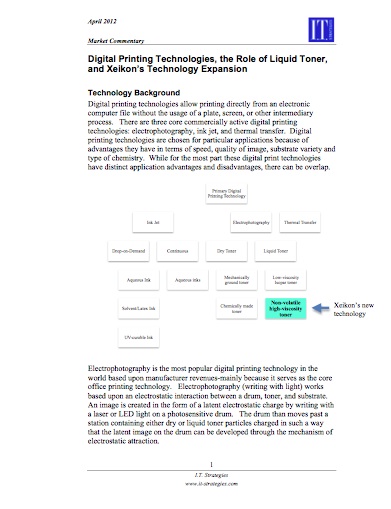 High Viscosity liquid Toner technology promises significant productivity gains and opens new markets for Xeikon
High Viscosity liquid Toner technology promises significant productivity gains and opens new markets for Xeikon
I.T. Strategies, a Boston-based consultancy specializing in the digital printing industry, has released a white paper on the role of liquid toner and Xeikon's current technology expansion into this area. The key conclusions of the white paper are that Xeikon's ownership of the key patents for a High Viscosity liquid toner technology, has given the company a dramatic shortcut in both time-to-market and investment to develop a new liquid toner technology. With the promise of lower running costs and significant speed improvements, while maintaining the high quality level of its dry toner presses, the new technology will offer significant productivity gains to customers specializing in high volume print applications. At the same time, it provides the opportunity for Xeikon to extend its customer base to those printing specialty applications such as consumer photo books and other high-value documents.
Starting with a brief history lesson on digital printing technologies, the white paper explains in simple terms the technology of electrophotography and outlines the difference between dry and liquid toners. While both toner technologies strive to create the smallest particles possible in order to optimize quality, liquid toner has greater latitude to control the particles. As such, liquid toners use less material which reduces raw materials costs, allow faster linear throughput speeds and use less heat (hence energy cost) to fuse to the substrate.
A long-established history
Liquid toner has a long-established history, pre-dating the commercialization of drop-on-demand inkjet technology. When Xeikon acquired ownership of the key patents for the HVT and technology, it gained more than fifty years of liquid toner development giving the company a dramatic shortcut in both time-to-market and investment to develop a liquid-based toner. It is the view of I.T. Strategies that Xeikon benefitted from decades of significant prior investment and learning curve for a fraction of the cost. With its R&D teams of both printer hardware and toner under one roof, I.T. Strategies anticipates that Xeikon can compress the amount of time necessary to commercialize its new liquid toner technology.
More productive than dry toner
I.T. Strategies foresees that the new liquid toner technology will be even more productive than dry toner technology, while maintaining the same high printing quality. While initial throughput is projected to be
60 m/min (196 ft/min), in theory upper limits of 300 m/min (1,000 ft/min) are possible. This ability to produce higher volumes digitally at lower cost will deliver significant productivity gains to printers and extend the breakeven point for digital printing. At the same time, it provides the opportunity for Xeikon to extend its customer base to those printing high value, high area coverage type documents.
Xeikon can leverage experience in dry toner and engine development
"Given its ability to leverage its experience in dry toner manufacturing and engine development, Xeikon's investment in liquid toner makes a lot of sense," says Marco Boer for I.T. Strategies. "Many of the skills required to develop a liquid toner printer are similar to those used to develop dry toner technology, thus the work ahead for Xeikon is in the printing system rather than engine development – something Xeikon know well."
While Xeikon has yet to prove it will successfully commercialize its investment, I.T. Strategies believes the odds are in their favor and they predict that the first commercial product will be available within the next two years.





























































































